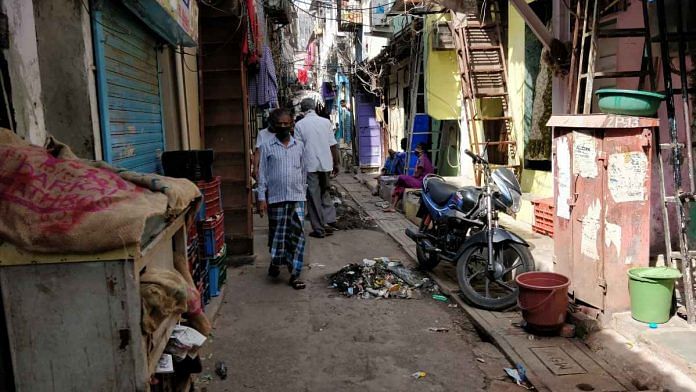Mumbai: Covid-19 cases are rising in Maharashtra once again and the slum sprawl Dharavi in Mumbai, which was one of the deadliest hotspots of the pandemic last year, has also reported a fresh surge.
Active cases in Dharavi — Asia’s largest slum — increased sevenfold to 73 as of 4 March from just 10 cases on 22 January.
The Brihanmumbai Municipal Corporation (BMC), therefore, has taken stringent measures to prevent the situation from escalating, as it had done in mid-2020 when the pandemic was at its worst in the city.
“We have gone back to our old model that helped us contain the spread last year. We have aggressively started screening people from the slum and conducting tests. We are testing almost 15-20 people for every positive case that we find,” said Kiran Dighavkar, assistant municipal commissioner, in charge of BMC’s G North administrative ward, which covers Dharavi.
Also read: Single dose of Pfizer, AstraZeneca vaccines effective, work against UK variant too — Study
New cases rise to double digits again
By the end of 2020, the number of daily cases in Dharavi dropped to single digits and even hit zero on four occasions — once in December and on three more days in January.
However, the daily numbers are rising to double digits again with the entire state, including Mumbai, seeing a spurt in Covid cases since the second week of February.
In the past eight days, Dharavi reported new cases in double digits on most days. On 28 February, 11 new cases were recorded, another 11 were seen on 1 March, 8 on 2 March and 14 new cases were registered on 3 March.
“We observed that the infection started from SRA (Slum Rehabilitation Authority) and MHADA (state housing board) buildings in Dharavi, but we are now also seeing cases in slums. The community toilets are the superspreaders,” Dighavkar said.
He added, the BMC has set a target of screening the entire population of Dharavi for temperature and oxygen levels in the next eight days.
“Those with symptoms are immediately being made to undergo RT-PCR tests. We have also made testing facilities available at nine health posts in Dharavi. The number of people in our institutional quarantine centres has grown, but this time the infection does not seem to be as severe,” the assistant commissioner said, adding that there has not been much demand for hospital beds or ventilators.
According to him, the G North ward is conducting 100-150 tests in Dharavi every day, while this number was barely 10-20 in January.
Furthermore, the number of people under institutional quarantine in Dharavi has increased to 94, from just 3 in the first week of February.
Also read: Maharashtra reports highest daily Covid cases in 4 months, active cases in India at 1,73,413
Dharavi’s Covid curve
Dharavi, which is home to 8.5 lakh people living in cramped quarters within a 2.5 square kilometre area, recorded its first Covid case on 1 April last year.
Enforcing social distancing and lockdown was impossible in the area and every person ended up being a high-risk contact because of the population density.
After the first positive, cases spiralled. According to civic data, in April itself, 491 Covid cases were diagnosed in Dharavi and in the following month, the number of cases shot up to 1,216.
However, officials immediately swung into action and by mid-June, it seemed like Dharavi was flattening the curve and new cases drastically plummeted to 480 in June.
Instead of social distancing in an area with a population density of 3.54 lakh people per square kilometre, civic officials resorted to rigorous contact-tracing, creating large quarantine facilities and isolating vulnerable populations, regularly cleaning community toilets to maintain hygiene, taking over private hospitals for treatment and ramping up testing.
The success story won international accolades as the ‘Dharavi model’ and also received praise from the World Health Organization.
Also read: Antigen test at venue, couples counselling — how Maharashtra’s tackling super-spreader weddings



